Pezzetti Moka Pot Review
The Pezzetti is an Italian stovetop coffee maker. It's trying to compete with the famous Bialetti brand, which has been the standard since 1933. Pezzetti’s main selling point is its wide range of colors and models.
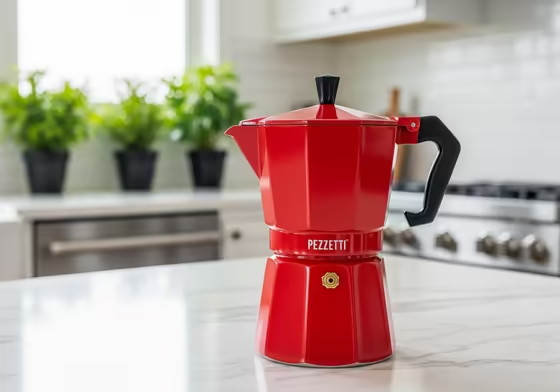
This review will cover Pezzetti's different models and the quality of coffee they make. We'll also look at where they are made and how they stack up against other brands. This should help you decide if it's the right coffee pot for you.
Pezzetti's Different Moka Pots
Pezzetti basically sells two types of moka pots. The Italexpress is made of aluminum for regular stovetops. The Steelexpress is stainless steel and works on modern induction stoves.

Induction Moka Pots (Steelexpress)
If you have an induction stove, you need the Pezzetti Steelexpress. Regular aluminum moka pots don't work on induction cooktops.
- How it Works: Traditional moka pots are aluminum, which doesn't heat up on induction stoves. The Pezzetti Steelexpress is made of stainless steel so it works on induction. It also works fine on regular gas and electric stoves.
- Looks and Materials: The Steelexpress is made of stainless steel and often has a colorful enamel coating. It comes in colors like silver, green, blue, purple, and orange. The bright colors are a big part of how Pezzetti markets its pots.
- Available Sizes: You can get the Steelexpress in 2-cup, 4-cup, 6-cup, and 10-cup sizes.
Pezzetti can't beat Bialetti on history alone. So, they use the colorful Steelexpress to appeal to people who care about looks. It's for customers who have a modern kitchen.
Large Pezzetti Moka Pots
This section explains what "large" means for a Pezzetti pot. First, you need to understand how moka pot sizes work.
- What a "Cup" Means: A moka pot "cup" isn't a normal measuring cup. It's a small espresso-sized shot, which is about 2 fluid ounces. So a 3-cup pot only makes about one small coffee.
- Pezzetti Sizes: The standard aluminum Italexpress comes in 1, 2, 3, 6, 9, and 14-cup models. Some people have even seen an 18-cup version.
-
"Large" Sizes Explained:
If you need a large pot, you're looking for one that can serve a few people at once.
- 6-Cup (approx. 10 oz): This is a common size that makes about two small mugs of coffee.
- 9-Cup (approx. 14 oz): This is good for serving 3 or 4 people.
- 14-Cup & 18-Cup: These are the really big ones for making coffee for a group.
But some people have noticed problems with the larger pots. One user said their 3-cup pot was great for a decade, but their 6-cup pot had a defect that caused it to leak. Another person said their 6-cup felt too lightweight.
This suggests that the quality might not be consistent on the bigger models. If you buy a large Pezzetti pot, there might be a higher risk of getting one with a problem.
Does Pezzetti Make a Yellow Moka Pot?
It looks like Pezzetti doesn't actually make a yellow moka pot. This seems to be a case of brand confusion.
Pezzetti does focus on making colorful pots. The aluminum ones come in red, black, and silver. The steel ones come in green, blue, lilac, and orange.
If you're searching for a "yellow moka pot," you are probably thinking of Bialetti. Their Rainbow line has a well-known bright yellow pot. This shows that people often shop by color, and in this case, Bialetti gets the sale.
How to Use a Pezzetti Moka Pot
Making coffee in a moka pot is pretty simple. But you need to get the grind, tamping, and heat just right. Doing it correctly helps you avoid the bitter taste and sputtering that can happen.
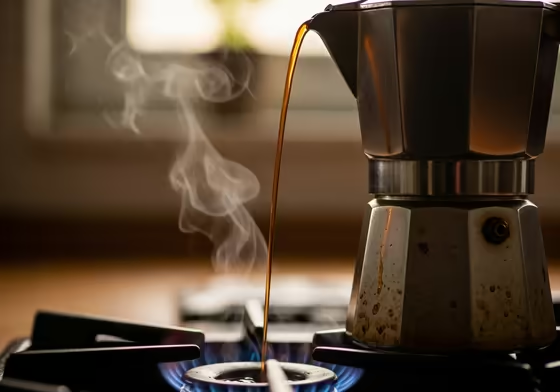
Step-by-Step Brewing Guide
Here is a simple guide to brewing with a Pezzetti moka pot.
- Take it apart: Unscrew the top part from the bottom boiler. Then take out the filter funnel that sits inside.
- Add Water: Fill the bottom boiler with water up to the little safety valve. Do not cover the valve. Using hot water (not boiling) can make the coffee taste less bitter.
-
Add Coffee:
Put the filter funnel back into the boiler. Loosely fill the funnel with ground coffee.
- Grind Size: Use a medium-fine grind. It should feel a little gritty, not like a fine powder. A grind that is too fine will block the filter.
- The Most Common Mistake: Do not press down or tamp the coffee. Moka pots aren't espresso machines. Tamping the grounds is the main reason moka pots sputter.
Crucial Tip: Never tamp (press down) the coffee grounds in a moka pot. This is the #1 cause of sputtering and bitter coffee. The grounds should be level and loose in the funnel. - Reassemble: Wipe any loose coffee grounds from the rim. Screw the top part on tight, but don't use the handle for leverage or it might break.
- Brewing: Put the pot on low to medium heat. High heat will make the coffee shoot out and taste burnt. If you have a gas stove, make sure the flame doesn't go up the side of the pot.
- Listen and Watch: After 3 to 6 minutes, the coffee will start to flow in a steady stream into the top part.
- Stop the Extraction: When you hear a gurgling or hissing sound, take the pot off the heat right away. This stops the coffee from getting a burnt, bitter taste.
- Serve: Before you pour, give the coffee a quick stir in the upper chamber. This mixes the stronger coffee from the beginning with the weaker coffee from the end.
Using the Steelexpress on Induction
Using the Steelexpress is the same as using the aluminum version. The only difference is the stove you can use it on.
The Steelexpress works on all stoves, including induction. A key tip for induction users is to use a low to medium power setting. Induction heats up very fast and can easily scorch the coffee, making it taste burnt.
Cleaning and Replacing Parts
Taking care of your Pezzetti pot will help it last a long time. Cleaning it the right way is the most important thing.
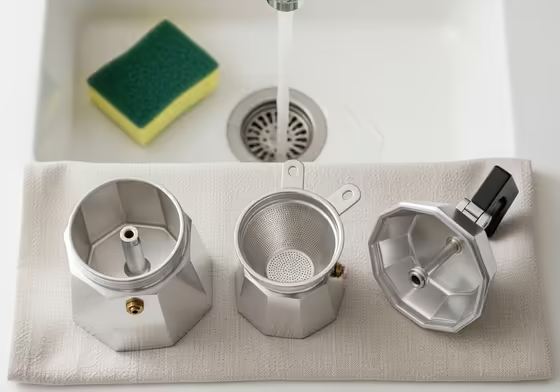
How to Clean Your Pezzetti
Yes, the moka pot is easy to clean, but you have to follow some rules. This is especially true for the traditional aluminum models.
- The "No Dishwasher" Rule: This is the most important rule for aluminum moka pots. Harsh dishwasher soap will cause a chemical reaction with the aluminum. It will ruin the pot, leaving it with a dark, pitted finish.
- The "No Soap" Rule (for Aluminum): The traditional Italian method is to never use soap. Soaps can be harsh on the aluminum or leave a residue that changes the taste of your coffee.
-
Correct Daily Cleaning (Aluminum Italexpress):
- Let the pot cool down completely.
- Take all three parts apart: the top chamber, the filter funnel, and the bottom boiler.
- Rinse all parts thoroughly with warm water.
- This step is very important: Dry every part completely with a cloth before reassembling. Storing the pot while it's damp will cause the aluminum to pit and get damaged over time.
- Deep Cleaning (Aluminum): To remove mineral buildup, do a brew cycle without coffee. Instead, use a 50/50 mix of white vinegar and water. Discard the solution and rinse all the parts.
- Cleaning the (Stainless Steel) Steelexpress: This model is much easier to clean. Stainless steel is fine with mild dish soap. But hand-washing is still best to protect the silicone gasket and any colorful finish.
Finding Replacement Gaskets and Parts
Over time, the gasket (the rubber or silicone seal) and the filter plate will wear out. They need to be replaced. These parts are usually sold together in kits.
It can be hard to find Pezzetti-branded replacement parts, especially in the US. But here's the good news: Pezzetti pots use standard sizes.
This means you can use Bialetti-brand gaskets and filters that match your pot's cup size. This is really helpful for Pezzetti owners because Bialetti parts are much easier to find.
To make sure you buy the right size, you should measure your existing parts. The table below provides a guide to help you find the correct measurements for your pot.
Pezzetti Replacement Gasket & Filter Sizing Guide
| Model | Cup Size | Gasket Material | Gasket Outer ∅ (mm) | Gasket Inner ∅ (mm) | Filter Plate ∅ (mm) |
|---|---|---|---|---|---|
| Italexpress (Aluminum) | 1-Cup | Rubber | 50–51 mm | 38–40 mm | approx. 40 mm |
| Italexpress (Aluminum) | 3-Cup | Rubber | 63–65 mm | 49–50 mm | 55 mm |
| Italexpress (Aluminum) | 6-Cup | Rubber | 70–72 mm | 54–55 mm | 64 mm |
| Italexpress (Aluminum) | 9-Cup | Rubber | 81 mm | 64 mm | (data not available) |
| Italexpress (Aluminum) | 14-Cup | Rubber | 92 mm | 76 mm | (data not available) |
| Steelexpress (Steel) | 2-Cup | Silicone | 52–53 mm | (data not available) | 44–45 mm |
| Steelexpress (Steel) | 4-Cup | Silicone | 64–65 mm | (data not available) | 56–57 mm |
| Steelexpress (Steel) | 6-Cup | Silicone | 74–75 mm | (data not available) | 63 mm |
| Steelexpress (Steel) | 10-Cup | Silicone | (data not available) | (data not available) | (data not available) |
More About Pezzetti Pots
This section answers some common questions about the brand. This includes the tricky subject of where the pots are actually made.
Where Are Pezzetti Moka Pots Made?
This is a confusing question with conflicting answers online. Here's what the evidence shows.
-
Claim 1: "Made in Italy"
Pezzetti is an old Italian company, started in the 1940s. Many online stores say the pots are made in Italy. Older, vintage models often have a "Made in Italy" stamp. -
Claim 2: "Made in China"
But many users online say their newer pots are made in China. Some store product data also lists China as the country of origin.
So what's the real story? Both claims are probably true, just for different times. Pezzetti is an Italian brand, and its older pots were almost certainly made in Italy.
However, to compete with Bialetti on price, it's very likely they moved production for their main aluminum pots to China. This move seems to be linked to complaints about quality. People say the Chinese-made pots feel thinner and are more likely to have defects.
So, while Pezzetti is an Italian brand, its newer aluminum pots are probably made in China. Be careful if you are looking for one that is specifically made in Italy, as online descriptions can be wrong.
Is Pezzetti Made of Stainless Steel?
This depends on which model you're talking about.
- Pezzetti Italexpress: This is the brand's classic model. It is made of aluminum. It is not stainless steel and will not work on an induction stove.
- Pezzetti Steelexpress: This is the brand's modern line. It is made of stainless steel. This makes it durable and compatible with all stovetops, including induction.
Pezzetti's Official Website
The official brand website for Pezzetti is: pezzetticaffettiere.it. The website has information about the brand's history and design ideas.
Reviews: How Good is Pezzetti?
This section looks at what experts and users say about how well Pezzetti pots actually work. This is especially important when comparing them to their main competitor.
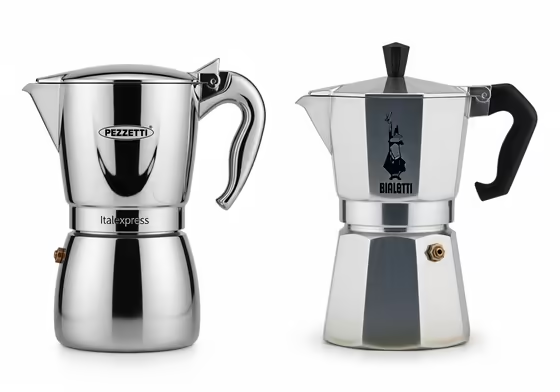
Pezzetti Moka Pot Review
Hands-on reviews of the main aluminum model, the Italexpress, are mostly negative.
- The Verdict and Taste: One detailed review gave the Pezzetti Italexpress a 1-out-of-5 star rating. The coffee it made was described as watery, bitter, and metallic. It failed to deliver the rich, strong brew you expect from a moka pot.
-
The Reason: A Big Design Flaw
The bad taste isn't just a mistake in brewing. It's because of a flaw in the design. The pot's coffee basket is too shallow, so it can't hold enough coffee grounds for the amount of water it uses. By design, it is set up to make weak coffee.
-
Build Quality and Other Problems:
- Manufacturing Defects: As mentioned before, people often report defects. This includes roughly finished rims, funnels that aren't perfectly round, and pressure leaks. This all points to lower quality control.
- Poor Design: The pot is basically a knock-off of the Bialetti Moka Express. In tests, the spout drips when you pour. The handle is also described as too thin and painful to hold when the pot is full.
What Moka Pot Do Italians Use?
The answer is simple: Bialetti.
The Bialetti Moka Express is not just a coffee maker, it is a key part of Italian culture. Invented in 1933, it is the original design. It's found in almost every Italian home.
While other fancy Italian design brands exist, Bialetti is the undisputed pot of the Italian people.
What's the #1 Moka Pot Brand?
Globally, the number one brand in moka pots is Bialetti. This is based on its history, name recognition, and sales.
It is consistently rated the "Best Moka Pot" by expert reviewers. The reason is that its design is correct. It is made from heavy aluminum that heats evenly and its filter basket is large enough for the right coffee-to-water ratio.
This analysis shows Pezzetti's true place in the market. Pezzetti is a budget knock-off. It competes by being cheaper and offering more colors, but this lower price is because of cheaper manufacturing, low-quality materials, and a flawed design.
What Is a Moka Pot, Anyway?
To fairly judge any moka pot, you need to know what this coffee maker is, and what it is not. This section provides some helpful background info.
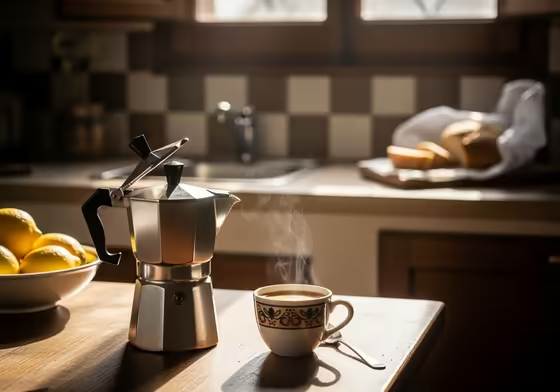
Why Are Moka Pots So Popular in Italy?
The moka pot's place in Italian culture is built on three things:
- Cultural Ritual: It is a daily ritual in Italian homes. The gurgling sound of the coffee maker is a cherished part of life.
- A Gesture of Hospitality: In Italy, offering a guest a coffee made in the moka pot is a fundamental sign of welcome and sharing.
- Making Coffee Affordable: Before the moka pot was invented, espresso was an expensive drink you could only get in public cafes. The moka pot let every family make strong, espresso-like coffee at home, affordably.
What's Special About Moka Pots?
The moka pot is special because it creates a unique kind of coffee that's in its own category.
- How It Works: It's a stovetop brewer that uses steam pressure. Water in the bottom chamber boils, and the steam builds pressure. This pressure forces the hot water up through the coffee grounds and into the top chamber.
-
It's Not True Espresso:
This is the most important concept to understand. Moka pot coffee is not real espresso.
- A moka pot brews at a low pressure of about 1 to 1.5 bars.
- True espresso, by definition, requires a high pressure of 9 bars.
Moka vs. Espresso: Remember, a moka pot brews with low pressure (1-1.5 bars), creating a strong, concentrated coffee. True espresso requires high pressure (9 bars) to create its signature thick body and crema. -
How This Affects the Final Cup:
- Moka coffee has a thin to medium body, while a 9-bar espresso is thick and syrupy.
- Moka pots do not produce true crema, which is the reddish-brown foam on top of a real espresso.
- The taste of moka coffee is strong and bold. But compared to a good espresso, it is often more bitter and can have a harsh profile.
Are Moka Pots Worth It?
This question has two parts: one about the brewing method and one about the Pezzetti brand.
- The Method: As a brewing category, moka pots are absolutely worth it. They are an affordable way to make strong, espresso-like coffee at home. They are durable and produce a uniquely satisfying cup of coffee.
-
The Brand (Pezzetti):
Based on the evidence, the Pezzetti moka pot is not worth it. The reviews show its design is flawed, with a shallow basket that guarantees a watery brew. User reports point to poor build quality and defects, likely from cutting costs with its manufacturing.
The original brand, Bialetti, is similarly priced and does not have these design or quality flaws. You are much better off buying the benchmark Bialetti Moka Express.
Are Moka Pots Popular in Europe?
Yes, moka pots are very popular in Europe. They are most commonly used in Europe, Latin America, and Australia. They are everywhere in Italy, very common in Spain, and also popular in other countries.
Do Americans Use Moka Pots?
Moka pots are more of a niche product in the United States, where drip coffee is king. They are seen less often here. However, their popularity is growing, often with coffee lovers looking for an affordable way to make espresso-like coffee at home.